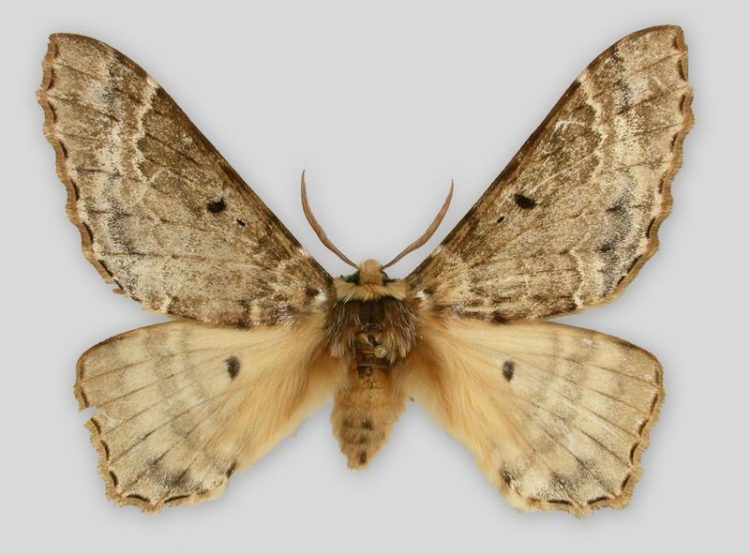A new family of Macrolepidoptera discovered

One collection specimen of Pseudobiston pinratanai in the lepidoptera collection of State Museum of Natural History Stuttgart. Copyright: SMNS
A moth searching for its relatives: it may take many years from the discovery of a species and its scientific description to its systematic classification. For the moth family “Pseudobistonidae” it took 26 years of research.
Now an international research cooperation with experts from the Natural History Museums in Stuttgart and Bonn (Germany) scientifically described the new family. The results of this study have been published in the scientific journal Scripta Zoologica.
The first specimen of the moth Pseudobiston pinratanai was captured in 1989 in northern Thailand and was described in 1994 by Japanese lepidopterist Hiroshi Inoue.
This specimen belonged to an unknown species and genus. However, its higher systematic placement was also unclear. The combination of the morphological characters of Pseudobiston pinratanai at first did not allow a consistent classification within Macrolepidoptera. As no genetic data were available at that time, scientists could not solve the puzzle until much later.
Together with colleagues from the Natural History Museums in Bonn and Paris as well as the Universities of Vienna and Turku, Dr. Hossein Rajaei has worked since 2012 on a scientific research study to define the systematic position of Pseudobiston pinratanai. In a combined integrative approach of classic morphological and molecular methods, the scientists were able to unravel the systematic position of this enigmatic species. The molecular results confirmed what the experts had already suspected:
Pseudobiston pinratanai does not belong to the family of so-called geometer moths (Geometridae), but instead represents a separate lineage within Macrolepidoptera and shows a close relationship to the species-poor Asian family Epicopeiidae. In the second part of their study, the researchers found multiple morphological characters that confirmed the molecular results.
They compared characters of all major body parts, especially the head, thorax, and wings, and compared them to other families of Macrolepidoptera. Thus Pseudobiston pinratanai was assigned as sole member of the new family Pseudobistonidae.
“This research shows how important the synthesis of comparative and molecular genetic methods is for the determination of species. Integrative taxonomy, the interplay of these different methods, is a critical area of expertise of natural history research museums. The discovery of Pseudobistonidae also makes it clear how productive collaborations between natural history museums can be.
I congratulate my colleagues on this great success”, states Johanna Eder, director of the State Museum of Natural History in Stuttgart. “Integrative taxonomy must be seen as a very useful instrument to support scientific work within the framework of ecological research”, adds Prof. Dr. Bernhard Misof, Deputy Director of the Zoological Research Museum Alexander Koenig – Leibniz Institute for Animal Biodiversity in Bonn.
Establishing a new family of butterflies is a rare event: The last description of a new family of Macrolepidoptera was published over 20 years ago.
“We were able to explore family relationships and other characteristics during this extensive research, which has given us new insights into the evolution and development of butterflies. The discovery of a new family of large butterflies is for me of course spectacular”, enthuses Dr. Hossein Rajaei, entomologist and Lepidoptera expert at the State Museum of Natural History Stuttgart. Two specimen of Pseudobiston pinratanai are part of the collections of the State Museum of Natural History Stuttgart.
Source:
Rajaei H., Greve, C., Letsch, H., Stüning, D., Wahlberg, N., Minet, J., Misof, B. (2015). Advances in Geometroidea phylogeny, with characterization of a new family based on Pseudobiston pinratanai (Lepidoptera, Glossata). Scripta Zoologica. doi:10.1111/zsc.12108
http://onlinelibrary.wiley.com/doi/10.1111/zsc.12108/abstract
http://www.naturkundemuseum-bw.de
http://www.zfmk.de
Media Contact
All latest news from the category: Life Sciences and Chemistry
Articles and reports from the Life Sciences and chemistry area deal with applied and basic research into modern biology, chemistry and human medicine.
Valuable information can be found on a range of life sciences fields including bacteriology, biochemistry, bionics, bioinformatics, biophysics, biotechnology, genetics, geobotany, human biology, marine biology, microbiology, molecular biology, cellular biology, zoology, bioinorganic chemistry, microchemistry and environmental chemistry.
Newest articles

Properties of new materials for microchips
… can now be measured well. Reseachers of Delft University of Technology demonstrated measuring performance properties of ultrathin silicon membranes. Making ever smaller and more powerful chips requires new ultrathin…

Floating solar’s potential
… to support sustainable development by addressing climate, water, and energy goals holistically. A new study published this week in Nature Energy raises the potential for floating solar photovoltaics (FPV)…

Skyrmions move at record speeds
… a step towards the computing of the future. An international research team led by scientists from the CNRS1 has discovered that the magnetic nanobubbles2 known as skyrmions can be…





















